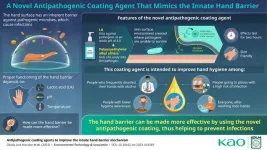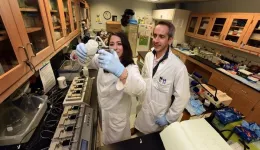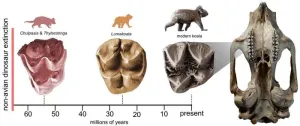(Press-News.org) Contact infection is among the most common ways pathogens, such as bacteria and viruses, spread from one person to another. Hand washing and disinfection are important hygiene practices to minimize the probability of catching infectious diseases. Interestingly, our hands also have a natural barrier that fights off pathogens. While this had been known to science for quite some time, the exact mechanisms by which this barrier acts on pathogens remained a mystery until recently.
In a 2021 study published in Scientific Reports, researchers from Kao Corporation, Japan, revealed that lactic acid (LA), which has a molecular formula of CH3CHCOOH, is the main active component of the natural hand barrier. Soon after, in a 2021 study published in Skin Research and Technology, they successfully elucidated the mechanisms by which the hand barrier helps kill pathogens. They found that sweat makes lactate (molecular formula of CH3CHCOO-) accumulate on the skin of the hands and that the low surface pH converts lactate into lactic acid (LA). The relatively high temperature of the hands disrupts the membrane of microbes and makes it permeable to LA. Once inside the pathogens, LA transforms back into lactate and releases the proton (molecular formula of H+). This lowers the internal pH of the microbe and causes DNA damage and metabolic problems.
Using this information, Kao researchers sought a practical way to boost the natural hand barrier to help prevent contact infections. In a joint research effort between Kao Corporation and Kyoto Prefectural University of Medicine, a team of scientists developed a coating agent that can greatly boost the antimicrobial properties of the natural hand barrier. This study was made available online on June 14, 2023, and published in Volume 32 of Environmental Technology & Innovation in November 2023. The project was led by Dr. Kenji Manabe, Manager of the Personal Health Care Products Research Department at Kao Corporation, and also included Assistant Professor Ryohei Hirose from the Kyoto Prefectural University of Medicine.
First, the researchers designed a prototype formulation for the coating agent consisting of LA and a surfactant called polyoxyethylene alkyl ether (POEAE). Through membrane permeability studies in the bacterium Serratia marcescens, they found that the lower the number of oxyethylene groups in the POEAE molecule, the easier it was for LA to pass through the cell membrane, resulting in higher antibacterial activity.
Afterwards, the research team conducted clinical trials on four adult subjects using the prototype formulation. They applied the coating agent on the forearm of the subjects in quantities similar to what one would normally apply when using a commercial hand sanitizer. These experiments showed that the coating agent retained high antimicrobial activity even two hours after the application, showcasing its potential in everyday life.
Finally, using a model skin evaluation system developed at the Kyoto Prefectural University of Medicine, the researchers quantitatively analyzed the survival time of various bacteria and viruses on human skin tissue samples to which the coating agent was applied. The results showed that the proposed formulation reduced the survival time of coronaviruses and influenza viruses from several hours to under half an hour. Additionally, the survival time of Serratia marcescens dropped from 284 hours to only 9 hours.
Overall, the findings of this study will pave the way for new hygiene products and practices that boost the natural hand barrier to prevent contact infection. These would have important implications in clinical practice and could change how people sanitize their hands. “Conventional hand hygiene behaviors, such as hand washing and disinfection, are insufficient to address all the contact infection risks. On the other hand, non-alcoholic disinfectants can remain effective on the hands but are known to cause skin irritation when used in high concentrations,” explains Dr. Manabe, “In contrast, the proposed skin coating agent is mild on the skin and has a long-lasting effect, making it is easy to use daily. If our newly developed formulation is habitually applied after hand washing, it could complement conventional hand hygiene and reduce the risk of contact infections.”
The development of such novel hand hygiene products will help not only keep contact infections at bay but also reduce stress. In this regard, Dr. Manabe concludes, “As we enter the post-pandemic period, hygiene awareness is declining, but many people are still more concerned about infection than ever before. Delivering more effective hand hygiene practices to such people in a way that is less burdensome to their lives can reduce the risk of infection while also delivering psychological relief.”
About Kao
Kao creates high-value-added products and services that provide care and enrichment for the life of all people and the planet. Through its portfolio of over 20 leading brands such as Attack, Bioré, Goldwell, Jergens, John Frieda, Kanebo, Laurier, Merries, and Molton Brown, Kao is part of the everyday lives of people in Asia, Oceania, North America, and Europe. Combined with its chemical business, which contributes to a wide range of industries, Kao generates about 1,550 billion yen in annual sales. Kao employs about 35,400 people worldwide and has 136 years of history in innovation. Please visit the Kao Group website for updated information.
Kyoto Prefectural University of Medicine
Kyoto Prefectural University of Medicine was established in 1872 (5th year of the Meiji Era) and is one of the oldest medical universities in Japan. In 2022, it celebrated the 150th anniversary of its founding. With the motto of “Bringing world-class medicine to the region,” the university offers top-level medical services by introducing advanced medical equipment at our hospital, diagnostics, and treatment for all stages of the disease. In addition to practical training at affiliated hospitals, students receive medical training in the form of community stays to learn about the structure of local medical care and the actual conditions in each region.
Website: https://www.kpu-m.ac.jp/doc/english/
END
Novel formulation boosts antimicrobial properties of the natural hand barrier
Researchers have developed a long-lasting skin coating agent that kills pathogens on the hands, paving the way to new hand hygiene practices to prevent contact infection
2023-09-07
ELSE PRESS RELEASES FROM THIS DATE:
US Department of Defense backs Cosimo Commisso’s pancreatic cancer research
2023-09-07
Cosimo Commisso, Ph.D., has received a grant from the Department of Defense for $1 million to advance the research of a small molecule that kills pancreatic cancer cells by disrupting their pH equilibrium. The project is funded as part of the Pancreatic Cancer Research Program (PCARP), which aims to improve our understanding of pancreatic cancer for the benefit of service members, veterans, their families and the general public.
“We’ve seen that this small molecule—called IMD-0354—works on cancer cells in the lab,” says Commisso, associate professor and director of the Cancer Metabolism and Microenvironment Program at Sanford Burnham Prebys. “This ...
High levels of depression found among Canadian older adults with cancer during the COVID-19 pandemic
2023-09-07
Toronto, ON —Older adults who have had cancer had a high risk of experiencing symptoms of depression during the early months of the COVID-19 pandemic according to a new study published in Cancer Management and Research.
The study was focused on a sample of 2486 adults aged 50 and older with a history of cancer who participated in the Canadian Longitudinal Study on Aging. Among the 1765 individuals from the study who had a history of cancer but no lifetime history of depression, researchers found that 1 in 8 experienced depression for the first time during the early stages of the pandemic.
“The ...
Timothy Huang awarded $2.6M to solve Alzheimer’s disease puzzle
2023-09-07
With the help of a new grant from the National Institute of Health for more than $2.6 million, Assistant Professor Timothy Huang, Ph.D., will continue his research on the role of the brain’s immune cells on the risk of developing Alzheimer’s disease.
Alzheimer’s disease affects more than 47 million people worldwide, with 10 million new cases of dementia diagnosed each year. This number will continue to grow as the world population ages. Newly approved FDA treatments for Alzheimer’s remove beta-amyloid, a protein that accumulates into plaques, from the brain. However, ...
Culture-friendly therapies for treating anxiety and depression in Japanese youth
2023-09-07
Cognitive-behavioral therapies (CBT) have become increasingly popular over the past few decades. This psychological treatment, used to treat problems ranging from marital issues, eating disorders, anxiety disorders and depression, has been adopted by clinicians around the world. However, the implementation of CBT still lags outside the Western countries where it was first developed.
In a new review article, researchers examined the most popular CBT programs for young people in Japan, a country that ...
Faulkner to be honored by American Heart Association
2023-09-07
AUGUSTA, Ga. (Sept. 7, 2023) – Jessica Faulkner, PhD, a physiologist whose research is focused on sex differences in cardiovascular disease at the Medical College of Georgia at Augusta University, is the recipient of the Harry Goldblatt Award for New Investigators from the American Heart Association’s 2023 Hypertension Council. She will be honored at the Hypertension Scientific Sessions in Boston this week.
This prestigious award is named for the pathologist who established the first animal model of hypertension in 1934 and recognizes an early career independent investigator working in hypertension or cardiovascular research who has significantly contributed ...
New test shows promise for detecting hard-to-find cervical cancers
2023-09-07
September 7, 2023—(BRONX, NY)—In findings with potentially important implications for cervical cancer screening, scientists at the National Cancer Institute (NCI)-designated Montefiore Einstein Cancer Center (MECC) have developed a test for detecting a type of cervical cancer that Pap tests often miss. The findings published online today in the Journal of the National Cancer Institute (JNCI).
“Our novel test appears sensitive for detecting cervical adenocarcinoma [ADC]—which now accounts for up to 25% of cervical cancer cases—as well as its precursor ...
New koala relative fills a branch of Australia’s unique marsupial story
2023-09-07
Koalas are endangered in much of Australia now but in in the past there were multiple species living across the continent. The discovery of an ancient relative of the koala helps fill a 30 million year gap in the amazing evolution of Australia’s marsupials, according to a new study by Australian and British scientists published in Scientific Reports.
The study was led by Flinders University PhD student Arthur Crichton, who found fossil teeth of the new species at the Pwerte Marnte Marnte fossil site south of Alice ...
Eye-tracking technology helps give a voice to older people living with dementia
2023-09-07
More than 50% of Australians living in residential aged care facilities have a dementia diagnosis, with aged care services around the world preparing for the number of older people aged 65 years and above to double in the next 30 years.
For the first time, experts at the Caring Futures Institute at South Australia’s Flinders University are using innovative eye-tracking technology to ensure that the voices of all older people are heard to drive positive and effective change in keeping with the Royal Commission into Aged Care Quality and Safety’s call to re-assess the quality of aged care in Australia.
The Flinders University ...
Capturing carbon in savannas: New research examines role of grasses for controlling climate change
2023-09-07
In recent years, the escalating impact of global warming has prompted efforts to reverse troubling trends, often by planting trees to capture and remove carbon dioxide from the atmosphere and store it. New research from a team led by Young Zhou, from the Quinney College of Natural Resources and the Ecology Center, shows that, in addition to trees, humble grasses also play an essential role in capturing carbon — more important than previously thought.
A recent initiative set its sights on capturing carbon in tropical savannas, an ecosystem characterized by shared space of trees and grasses. The project initiated ...
Street medicine filling a major gap by providing behavioral health care for people who are homeless
2023-09-07
Mental health and substance use disorders are prevalent among people experiencing homelessness, yet access to care for these health issues is challenging for people living on the streets. Now, a new survey conducted by a team of researchers from USC Street Medicine found that, in California, street medicine programs are helping to fill this gap, delivering critical, high-level mental health and substance use treatments to the state’s unsheltered population.
The survey, published in Community Mental Health Journal, shows that street medicine has the potential to serve as the basis for a strategy to expand access to behavioral health care for people who ...
LAST 30 PRESS RELEASES:
Numbers in our sights affect how we perceive space
SIMJ announces global collaborative book project in commemoration of its 75th anniversary
Air pollution exposure and birth weight
Obstructive sleep apnea risk and mental health conditions among older adults
How talking slows eye movements behind the wheel
The Ceramic Society of Japan’s Oxoate Ceramics Research Association launches new international book project
Heart-brain connection: international study reveals the role of the vagus nerve in keeping the heart young
Researchers identify Rb1 as a predictive biomarker for a new therapeutic strategy in some breast cancers
Survey reveals ethical gaps slowing AI adoption in pediatric surgery
Stimulant ADHD medications work differently than thought
AI overestimates how smart people are, according to HSE economists
HSE researchers create genome-wide map of quadruplexes
Scientists boost cell "powerhouses" to burn more calories
Automatic label checking: The missing step in making reliable medical AI
Low daily alcohol intake linked to 50% heightened mouth cancer risk in India
American Meteorological Society announces Rick Spinrad as 2026 President-Elect
Biomass-based carbon capture spotlighted in newly released global climate webinar recording
Illuminating invisible nano pollutants: advanced bioimaging tracks the full journey of emerging nanoscale contaminants in living systems
How does age affect recovery from spinal cord injury?
Novel AI tool offers prognosis for patients with head and neck cancer
Fathers’ microplastic exposure tied to their children’s metabolic problems
Research validates laboratory model for studying high-grade serous ovarian cancer
SIR 2026 delivers transformative breakthroughs in minimally invasive medicine to improve patient care
Stem Cell Reports most downloaded papers of 2025 highlight the breadth and impact of stem cell research
Oxford-led study estimates NHS spends around 3% of its primary and secondary care budget on the health impacts of heat and cold in England
A researcher’s long quest leads to a smart composite breakthrough
Urban wild bees act as “microbial sensors” of city health.
New study finds where you live affects recovery after a hip fracture
Forecasting the impact of fully automated vehicle adoption on US road traffic injuries
Alcohol-related hospitalizations from 2016 to 2022
[Press-News.org] Novel formulation boosts antimicrobial properties of the natural hand barrierResearchers have developed a long-lasting skin coating agent that kills pathogens on the hands, paving the way to new hand hygiene practices to prevent contact infection








